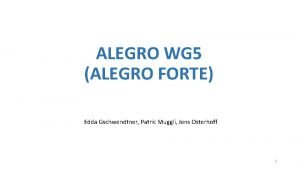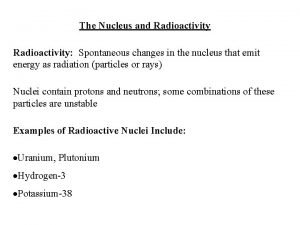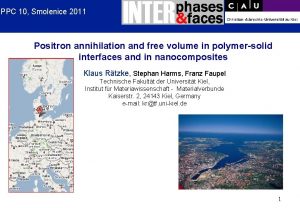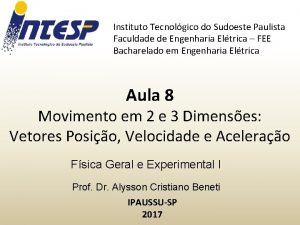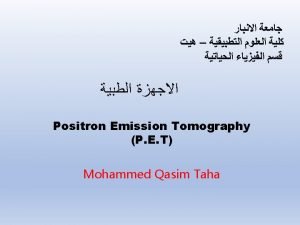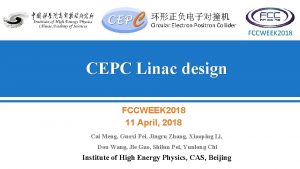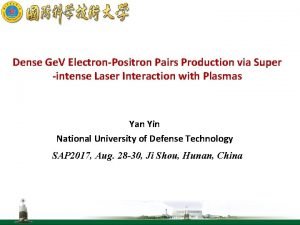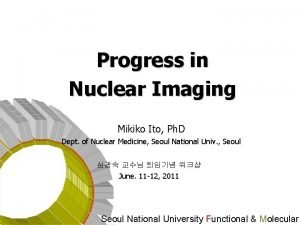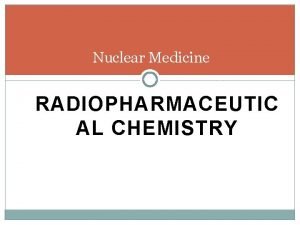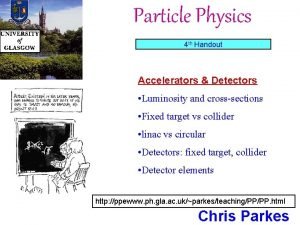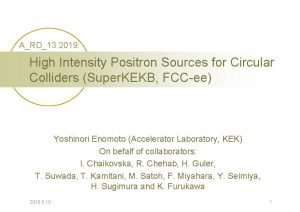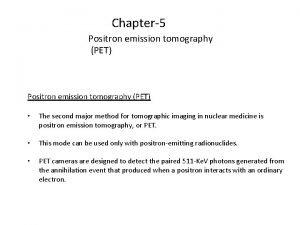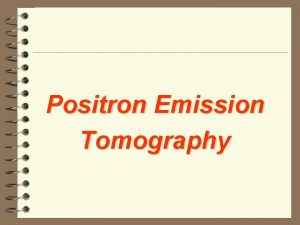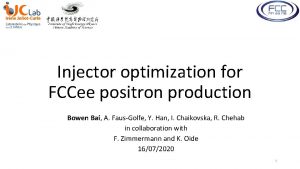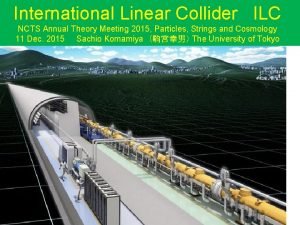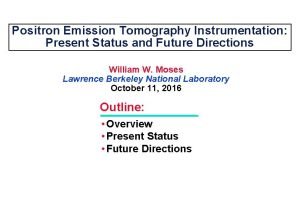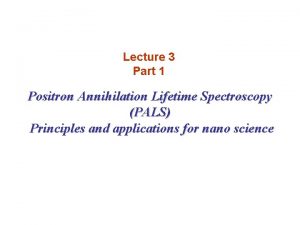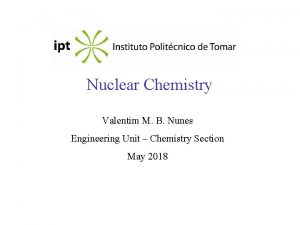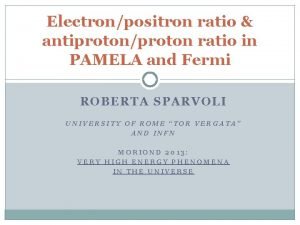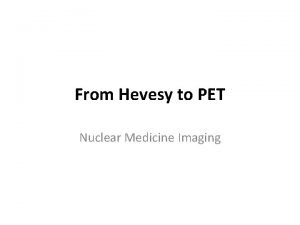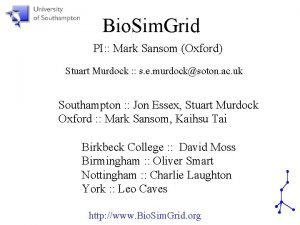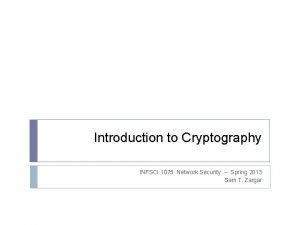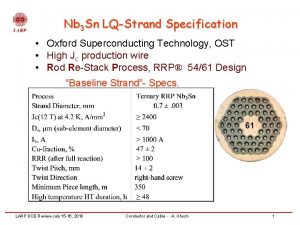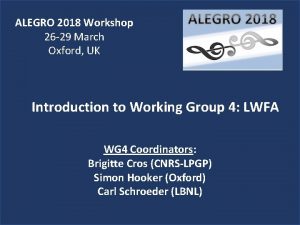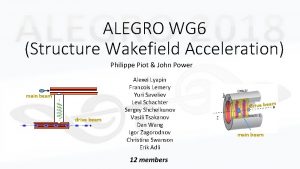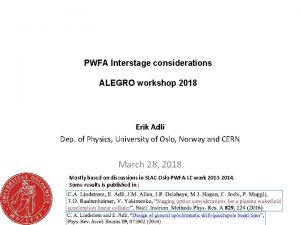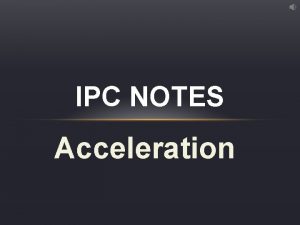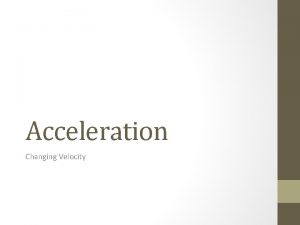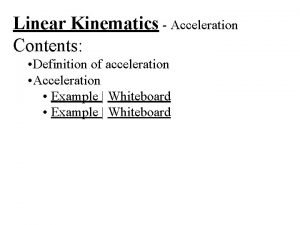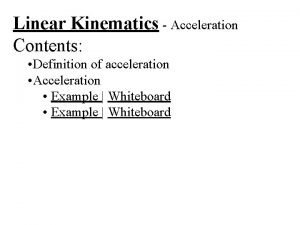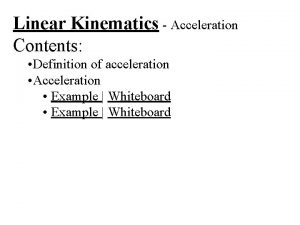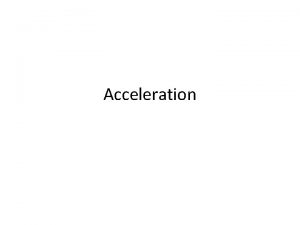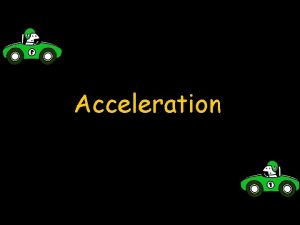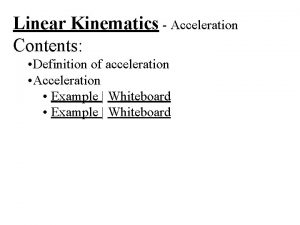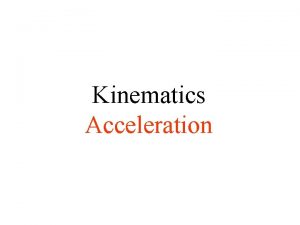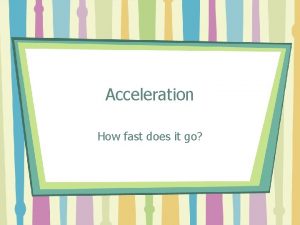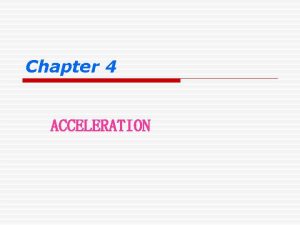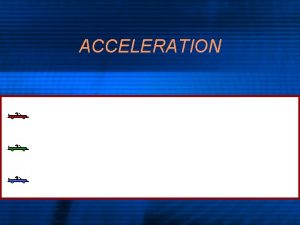ALEGRO 2018 workshop at Oxford Positron Acceleration in





























![Hollow plasma channels Ø Experimental measurement [C. Lindstrøm et al. , 2018] of transverse Hollow plasma channels Ø Experimental measurement [C. Lindstrøm et al. , 2018] of transverse](https://slidetodoc.com/presentation_image_h2/7910fb69b7d75c700427c6143aa79065/image-30.jpg)






- Slides: 36

ALEGRO 2018 workshop at Oxford Positron Acceleration in Plasma Introduction, Status and Objectives Sébastien Corde and Spencer Gessner WG 8 coordinators March 26, 2018 1

Outline • Introduction of the scientific context for positron acceleration in plasma Ø Motivation and relationship with LWFA-PWFA WG 4 and 5 Ø Difficulties for positron acceleration in plasma Ø No self-consistent scheme for simultaneously achieving high efficiency, low preserved emittance and transverse instability mitigation • Paths identified so far (all have major problems for linear colliders) Ø Quasi-linear plasma wakefield Ø Nonlinear plasma wakefield Ø Hollow plasma channels • WG 8 Status and Objectives Ø WG 8 CERN mini-workshop Ø WG 8 sessions at ALEGRO 2018 workshop Ø Identify path forward, potential issues, and R&D priorities 2

Introduction to Positron acceleration in Plasma 3

Plasmas are asymmetric accelerators Plasma acceleration schemes (both LWFA and PWFA) are promising candidates for an advanced linear collider. But plasmas are asymmetric accelerators: there are profound difference between electron and positron acceleration in plasmas. e- e+ mi >> me The plasma electrons are mobile but the ions are not. The symmetry of the accelerating mechanism is broken. Exception Linear plasma waves are symmetrical. 4

Plasmas are asymmetric accelerators Laser Direction LWFA laser driver PWFA particle beam driver Positron acceleration has very similar difficulties in both LWFA and PWFA. It would be beneficial to tackle the problem across the fields of LWFA and PWFA. WG 8 Positron acceleration is a joint sub-WG to LWFA-PWFA WG 4 and 5 5

Plasmas are asymmetric accelerators Electron-driven or laser-driven nonlinear blowout wakes: Where can be accelerated andregion. focused in a The But field is positrons accelerating behind the pinch in the first the field is defocusing in this non-linear bubble. plasma wakefield? 6

Plasmas are asymmetric accelerators Electron-driven or laser-driven nonlinear blowout wakes: Tiny volume for positrons Tiny volume where it’s simultaneously accelerating and focusing. But Ez varies 7 rapidly in this volume, both transversely and longitudinally.

Plasmas are asymmetric accelerators Electron-driven or laser-driven nonlinear blowout wakes: Tiny volume for positrons Transverse force is highly nonlinear in r emittance growth 8

Challenges of Positron acceleration in Plasma Linear plasma wakes (any driver): Driver Major problems: Ø Efficiency is low Ø Stable propagation of a witness positron bunch requires either high emittance or very low charge; otherwise it collapses and drives nonlinear wakefield. 9

Challenges of Positron acceleration in Plasma Hollow plasma channels: Major problem: Ø Transverse instability 10

Challenges of Positron acceleration in Plasma acceleration is being considered for an advanced linear collider, where positrons are strongly desired. Positron is half the equation we have to deal with! Yet very little research on how to accelerate positrons in plasmas. Mostly due to the lack of facilities delivering positrons for plasma acceleration research. « The most outstanding problem is the acceleration of positrons with bunch brightness, required for a linear collider » [Lebedev et al. , World Sci. (2016)]. 11

Challenges of Positron acceleration in Plasma As of now, no self-consistent scheme for accelerating positrons in plasma that can simultaneously provide: Ø High energy efficiency Ø Extremely low preserved emittance Ø Mitigation of transverse instabilities Plasma-based particle accelerators face a major challenge: The positron problem Deserve serious attention It’s all about beam quality and efficiency 12

Identified paths for positron acceleration in plasma 13

Nonlinear plasma wakefield 14

Nonlinear plasma wakefield Experimental results in 1. 3 m plasma Positron acceleration in nonlinear plasma wakefield: • Unexpected result: a large number of positrons are accelerated. Not just a tiny volume being accelerating and focusing for positrons. • Accelerated positrons form a spectrally-distinct peak with an energy gain of 5 Ge. V. • Energy spread can be as low as 1. 8% (r. m. s. ). • Energy extraction efficiency of about 30% is deduced. S. Corde et al. , Nature 524, 442 (2015) 15

Nonlinear plasma wakefield Transverse force is nonlinear in r, and is slice dependent. emittance growth Halo formation P. Muggli et al. , Phys. Rev. Lett 101, 055001 (2008) P. Muggli | ALEGRO Positron Acceleration in Plasma Mini-Workshop, CERN | February 9 2018 16

Nonlinear plasma wakefield Ø “Weird” bunch shape for radial equilibrium no emittance growth Ø If initially Gaussian, the bunch evolves with emittance growth until equilibrium (quasi-steady state) is reached, after which emittance is preserved. Ø Single-stage plasma accelerator to avoid emittance growth in multiple stages K. Lotov, Phys. Plasmas 24, 023119 (2017) K. Lotov | ALEGRO Positron Acceleration in Plasma Mini-Workshop, CERN | February 9 2018 17

Nonlinear plasma wakefield Plasma wake shaping using e. g. doughnut-shaped drivers linear focusing force Potential for high efficiency and preserved emittance in nonlinear plasma wakefield J. Vieira et al Proceedings of AAC (2014); N. Jain et al ar. Xiv (2015) Jorge Vieira | ALEGRO Positron Acceleration in Plasma Mini-Workshop, CERN | February 9 2018 18

Nonlinear plasma wakefield Plasma wake shaping using e. g. doughnut-shaped drivers linear focusing force Potential for high efficiency and preserved emittance in nonlinear plasma wakefield J. Vieira et al Proceedings of AAC (2014); N. Jain et al ar. Xiv (2015) Jorge Vieira | ALEGRO Positron Acceleration in Plasma Mini-Workshop, CERN | February 9 2018 19

Quasi-linear plasma wakefield 20

Quasi-linear plasma wakefield 1. 65 m upstream of the plasma entrance Drive charge: 460 p. C Trailing charge: 260 p. C Plasma density: 1 × 1016 cm-3 Emittance without Ti: 100 um x 10 um With Ti 300 um : 270 um x 60 um A. Doche et al. , Scientific Reports 7, 14180 (2017) 21

Quasi-linear plasma wakefield Ø Acceleration of a distinct positron bunch in a plasma Ø By varying incoming emittance, experiment spans nonlinear to quasi-linear regime A. Doche et al. , Scientific Reports 7, 14180 (2017) 22

Quasi-linear plasma wakefield Ø Stable propagation for trailing positron bunch requires high emittance or low charge. Ø Without stable propagation, the trailing positron bunch collapses and a nonlinear wavefield is generated same problems as discussed for nonlinear plasma wakefield Weiming An | ALEGRO Positron Acceleration in Plasma Mini-Workshop, CERN | February 9 2018 23

Quasi-linear plasma wakefield Ø Low emittance implies low charge, and therefore low efficiency per bunch. Ø “True” quasi-linear regime therefore requires multipulse/multi-bunch and/or energy recovery, to accommodate for the low efficiency per bunch and to reach good overall efficiency. S. Hooker et al. , J. Phys. B: At. Mol. Opt. Phys. 47, 234003 (2014); J. Cowley et al. , Phys. Rev. Lett. 119, 044802 (2017) 24

Hollow plasma channels 25

Hollow plasma channels The Hollow Plasma Channel is a structure that symmetrizes the response of the plasma to electron and positron beams. There is no plasma on-axis, and therefore no focusing/defocusing force from plasma ions. Plasma Wall 26

Hollow plasma channels 27

Hollow plasma channels We measure changes to the beam as the beam is translated in the transverse directions x and y. The beam size increases when the beam interacts with the plasma channel. Both the Kick Map and Beam Area Measurement (Volcano Plot) are consistent with an annular plasma channel. S. Gessner et al. , Nat. Commun. 7, 11785 (2016) 28

Hollow plasma channels Hollow plasma channel with two beams: At a bunch separation of 400 microns, the trailing bunch gains about 20 Me. V on average, while the drive beam loses about 11 Me. V. 29
![Hollow plasma channels Ø Experimental measurement C Lindstrøm et al 2018 of transverse Hollow plasma channels Ø Experimental measurement [C. Lindstrøm et al. , 2018] of transverse](https://slidetodoc.com/presentation_image_h2/7910fb69b7d75c700427c6143aa79065/image-30.jpg)
Hollow plasma channels Ø Experimental measurement [C. Lindstrøm et al. , 2018] of transverse wakefield in hollow plasma channel largely agrees with theoretical model [C. Schroeder et al. , Phys. Rev. Lett. 82, 1177 (1999)]. Ø Need mitigation mechanisms for transverse instability in hollow plasma channels. C. Lindstrøm et al. , Phys. Rev. Lett 120, 124802 (2018) 30

WG 8 Status and Objectives 31

Working Group 8 sessions ALEGRO WG 8 mini-workshop at CERN (February 9, 2018) Talks: Ø Review results from previous experiments Ø Get a common understanding of the challenges and proposed solutions Ø Look ahead to future experiments Discussion: Ø What are the major obstacles to accelerating high-quality positron beams in plasma? Ø There are many proposed solutions. What are their advantages and drawbacks? Ø There aren’t many facilities of positron PWFA/LWFA research. Is there anything we can do about it? Ø What about novel sources of positron beams for plasma acceleration experiments? 32

Working Group 8 sessions WG 8 session on novel positron sources: Tuesday @10: 30 There is only one facility that produces positron beams for plasma acceleration experiments. Increasing access to positron beams will accelerate positron PWFA/LWFA research. In this session we examine existing and novel technologies for producing positron beams in the context of a PWFA/LWFA research facility. Looking ahead, the LC community would benefit from compact, low-emittance positron sources if they can replace expensive damping ring complexes. 33

Working Group 8 sessions Positron Source Topics Compact Damping Rings In-Situ Positron Generation Positron Beams from Electro-static Traps Laser Generated Positron Beams V. Yakimenko, FACET-II TDR, SLAC-R-1072 J. Danielson, Rev. Mod. Phys. , Vol. 87, 2015 X. Wang, PRL 101, 124801 (2008) G. Sarri, Nat. Comm. , 6747, 2015 34

Working Group 8 sessions WG 8 joint session with LWFA WG 4: Tuesday @15: 30 Ø Detailed report on ALEGRO WG 8 mini-workshop at CERN Ø Hollow channels for positron acceleration in LWFAs Ø Discussion on positron acceleration in LWFA schemes WG 8 joint session with PWFA WG 5: Wednesday @10: 30 Ø Prospects and challenges for positron acceleration in the quasi-linear regime Ø Transverse wakefields in hollow plasma channels Ø Discussion on most viable paths moving forward for positron acceleration 35

Objectives Our goals Ø Survey existing work in LWFA/PWFA positron acceleration Ø Provide input by identifying most promising path and highlighting their potential limitations Ø Prioritize R&D on solving the most important problems and on exploring new promising ideas Ø Emphasize need for facilities for positron LWFA/PWFA research Quasi-linear plasma wakefield How to accelerate low emittance beams with high efficiency? Multi-pulse, energy recovery. Hollow plasma channels How to mitigate transverse instabilities? Position trailing bunch at zerocrossing of transverse wakefield, look for damping mechanisms. Nonlinear plasma wakefield How to preserve emittance? Doughnut-shaped wakes, weird trailing bunch shaping, single-stage accelerator. It’s all about beam quality and efficiency Positron problem deserves serious attention 36
 Senhor tu nos mandas amar sem medida
Senhor tu nos mandas amar sem medida Edda gschwendtner
Edda gschwendtner Radial acceleration definition
Radial acceleration definition Linear acceleration
Linear acceleration Centripetal force
Centripetal force Tangential acceleration and centripetal acceleration
Tangential acceleration and centripetal acceleration Angular acceleration
Angular acceleration Ready for invalsi
Ready for invalsi Positron emission equation
Positron emission equation Positron yacht
Positron yacht Um coelho atravessa um estacionamento
Um coelho atravessa um estacionamento Positron emission
Positron emission Positron
Positron Positron vs electron
Positron vs electron Positron emission tomography
Positron emission tomography Positron emission tomography
Positron emission tomography Positron vs proton
Positron vs proton Positron
Positron Positron symbol
Positron symbol Positron emission tomography
Positron emission tomography Positron
Positron Positron vs proton
Positron vs proton Positron emission
Positron emission Positron emission tomography
Positron emission tomography Gas separation
Gas separation Alpha beta gamma
Alpha beta gamma Positron
Positron George charles de hevesy
George charles de hevesy Dada la siguiente secuencia rusia 2018 rusia 2018
Dada la siguiente secuencia rusia 2018 rusia 2018 Sergeant at law canterbury tales
Sergeant at law canterbury tales Jonathan horbury oxford
Jonathan horbury oxford Bruce george oxford
Bruce george oxford Mark sansom oxford
Mark sansom oxford Dan selinger oxford
Dan selinger oxford Anne trefethen
Anne trefethen Product cipher
Product cipher Oxford superconducting technology
Oxford superconducting technology

